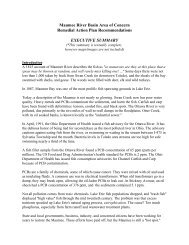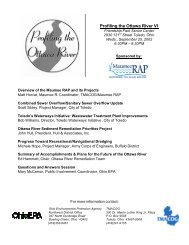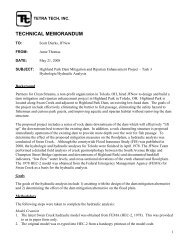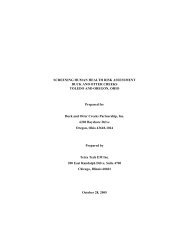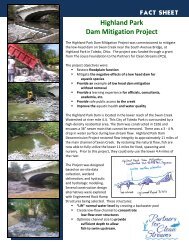Complete report - Partners for Clean Streams
Complete report - Partners for Clean Streams
Complete report - Partners for Clean Streams
Create successful ePaper yourself
Turn your PDF publications into a flip-book with our unique Google optimized e-Paper software.
Ohio EPA Recommendations<br />
Ongoing<br />
Issue 8 - Contaminated Stream Sediments<br />
Description:<br />
Lead Organization:<br />
The Ohio EPA has made multiple recommendations and has developed solutions to<br />
problems involving contaminated stream sediments. For example, the NPDES permit<br />
requires Whole Effluent Toxicity Testing <strong>for</strong> major dischargers. Others require testing<br />
<strong>for</strong> toxic organics but not Whole Effluent Toxicity Testing unless the WWTP show that<br />
the effluent toxicity is due to the industry. Also, the Ohio EPA requires a method of<br />
monitoring stream networks prior to NPDES permit renewal including discharger<br />
samples in the stream network. The results are shown in a Water Quality study. Due<br />
to the Water Quality Study, several dischargers are examined <strong>for</strong> quality to determine<br />
the quality of the overall stream system. This is also done in the TMDL process. The<br />
Ohio EPA uses the water quality criteria of the US EPA to control discharges and<br />
pollutants. Finally, the Ohio EPA en<strong>for</strong>ces permits limitations and penalizes those<br />
who do not comply.<br />
Ohio EPA<br />
Duck and Otter Creeks Sediment Quality Assessment Report<br />
1999<br />
Description:<br />
Lead Organization:<br />
McLaren/Hart completed an ecological evaluation of sediment chemistry data <strong>for</strong><br />
Duck and Otter Creeks. Ohio EPA Division of Emergency and Remedial Response<br />
and Division of Surface Water provided sediment data collected during multiple<br />
sampling events between 1992 and 1998. Analytical results were compiled <strong>for</strong> a total<br />
of 189 surface and subsurface samples from 121 sample locations. Analytical<br />
methods and the selection of chemicals <strong>for</strong> analysis differed among the various<br />
sampling programs.<br />
Sun Oil, BP-Amaco, Pilkington (contractor: ChemRisk – A Service of McLaren/Hart)<br />
Ottawa River Hot Spot Mapping<br />
1997<br />
Description:<br />
Members of the Maumee RAP Ottawa River Action Group, in particular Lee Pfouts,<br />
mapped the hot spots of the Ottawa River based on Ohio EPA's preliminary screening<br />
data from the Ottawa River sampling that was conducted as part of the MAOC project.<br />
This map was published in the Toledo Blade and served as a pre-cursor to the more<br />
<strong>for</strong>mal Ottawa River Hot Spot Delineation and Risk Assessment project (also<br />
described in this <strong>report</strong>). This map helped raise the public's awareness of local water<br />
and sediment quality issues and helped the Ottawa River Action Group identify<br />
potential contaminant sources.<br />
Ottawa River Hot Spot Delineation and Risk Assessment<br />
2000-2001<br />
Description:<br />
This study assessed the current risks posed by Ottawa River sediments and<br />
Activities and Accomplishments<br />
in the Maumee Area of Concern<br />
186<br />
Issue 8: Contaminated<br />
Stream Sediments



